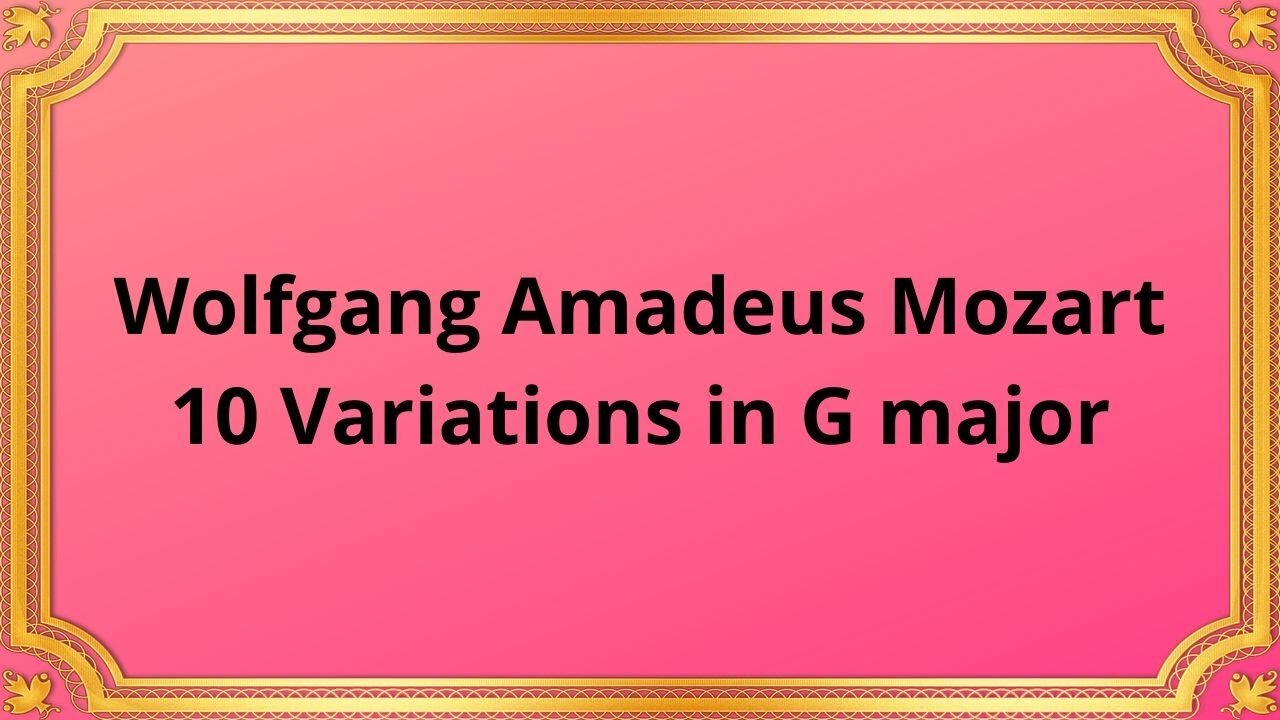Premium Only Content

Wolfgang Amadeus Mozart 10 Variations in G major
#Mozart#Chamber_music#Classical_music#Variations#Musical_composition
Publication date 1938
10 Variations in G major on ‘Unser dummer Pöbel meint’ from Gluck’s opera Die Pilgrime von Mekka K.455
Kathleen Long (piano)
Wolfgang Amadeus Mozart was a prolific composer of the classical era, famous for his symphonies, operas, and chamber music. One of his lesser-known works is the "10 Variations in G major," a set of variations for piano.
Mozart composed the "10 Variations in G major" in 1780 when he was 24 years old. The variations were written for piano and are based on a theme from a French opera by André Grétry called "Richard Coeur-de-lion." The variations were likely composed as a showpiece for Mozart's own performances.
The "10 Variations in G major" consist of a theme and ten variations. The theme is a simple, elegant melody that is presented in the opening bars of the piece. Each variation is based on this theme but features different musical elements, such as changes in harmony, rhythm, and texture.
The first variation features a lively rhythm and added ornaments, while the second variation is slower and more expressive. The third variation features a descending chromatic scale, and the fourth variation is characterized by intricate runs and trills. The fifth variation is a delicate, pensive variation, while the sixth variation is lively and playful. The seventh variation features rapid arpeggios and runs, while the eighth variation is more subdued and contemplative. The ninth variation is a virtuosic display of fast runs and arpeggios, and the final variation is a grand finale that brings the piece to a thrilling conclusion.
The "10 Variations in G major" are significant in that they showcase Mozart's virtuosic piano writing and his ability to create a wide range of musical moods and emotions within a single piece. The variations also demonstrate Mozart's skill at creating musical form and structure. Each variation is based on the same theme, but each one is distinct and unique, creating a sense of musical progression and development.
The variations are also significant in that they are an excellent example of Mozart's style. The elegance, balance, and clarity of the melodies, as well as the intricate harmonies and rhythmic interplay, are hallmarks of Mozart's music.
Conclusion
Wolfgang Amadeus Mozart's "10 Variations in G major" are a beautiful and significant work that showcases the composer's virtuosity, skill at form and structure, and unique style. The variations are a must-listen for anyone interested in classical music and are sure to delight and inspire.
-
 6:07
6:07
Classical music_Music Inspiration
27 days agoJoseph Haydn Piano Sonata in D Major, Hob. XVI:51
771 -
 1:02:45
1:02:45
Tundra Tactical
4 hours ago $10.76 earned🛑 KASH PATEL NEW ATF DIRECTOR??? Breaking News!!!! 🛑
32.9K7 -
 LIVE
LIVE
I_Came_With_Fire_Podcast
15 hours agoMy EURO Divorce | HOGG with a side of PAC | Foreign FUNDS Fudged
541 watching -
 37:44
37:44
Glenn Greenwald
11 hours agoGlenn On Tearing Down the Military Industrial Complex, Exposing Pro-Israel Indoctrination, and More | SYSTEM UPDATE #411
95.3K118 -
 4:04:20
4:04:20
Nerdrotic
10 hours ago $47.80 earnedAmazon Takes 007! Hollywood is Lost, Disney Cancels WHO? | Friday Night Tights 342 /w ItsAGundam
156K33 -
 43:27
43:27
Tucker Carlson
10 hours agoRay Dalio: America’s Hidden Civil War, and the Race to Beat China in Tech, Economics, and Academia
150K179 -
 56:56
56:56
Candace Show Podcast
10 hours agoEXCLUSIVE: Taylor Swift Will Be Deposed. | Candace Ep 150
165K145 -
 1:03:52
1:03:52
IsaacButterfield
7 hours ago $3.55 earnedRepublican Vs 25 Transgender Activists | Jewish Outrage | Lizzo Loses All the Weight
44.7K13 -
 1:10:23
1:10:23
Edge of Wonder
11 hours agoChinese Biochips Hacking Minds? Quantum Control & Journey Song Mandela Effect
71.6K8 -
 2:15:46
2:15:46
Quite Frankly
14 hours ago"Ghosts, Robotics, and OBE's" ft. Dr. Albert Taylor 2/21/25
67.1K17